| کد مقاله | کد نشریه | سال انتشار | مقاله انگلیسی | نسخه تمام متن |
|---|---|---|---|---|
| 6264728 | 1614024 | 2011 | 13 صفحه PDF | دانلود رایگان |

The primate somatosensory system provides an excellent model system with which to investigate adult neural plasticity. Here, we report immunohistochemical staining data for the GABAA α1, GABABR1a, and GABABR1b receptor subunits in somatosensory area 3b, and cuneate nucleus one week after median nerve compression in adult squirrel monkeys. We find a significant decrease in GABAA α1 subunit staining across all cortical layers and within both soma and neuropil of the deprived cortical and brainstem regions. The GABAB staining showed an opposing shift in deprived regions, with a significant increase in presynaptic GABABR1a staining, and a significant decrease in postsynaptic GABABR1b staining in deprived regions of the cortex and brainstem. These changes in receptor subunit expression generate patterns that are very similar to those reported in the neonate. Furthermore, the similarities between brainstem and cortical expression suggest conserved forms of adult plasticity in these two regions. Taken together these results, along with the results from our previous paper investigating AMPA subunit expression in these same animals, support the hypothesis that deprived neurons enter a previously hidden state of developmental recapitulation that serves to prime the brain for NMDA receptor mediated receptive field reorganization.
⺠The pattern of GABA subunit expression resembles developmental recapitulation. ⺠The developmental recapitulation is present in the cortex and brainstem. ⺠This previously hidden phase of somatosensory reorganization is likely inherent to other systems.
Journal: Brain Research - Volume 1415, 30 September 2011, Pages 63-75